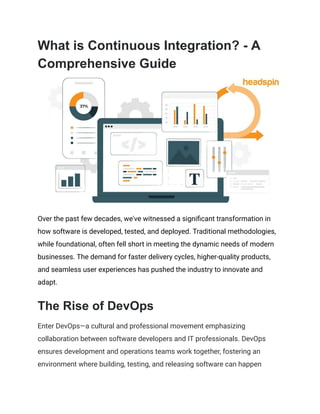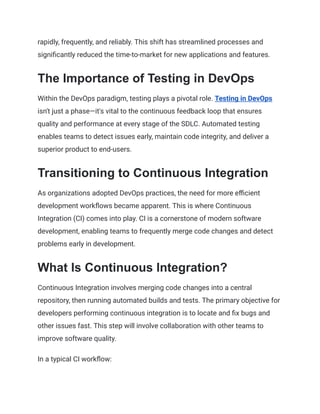What is Continuous Integration_ - A Comprehensive Guide.pdf
- 1. What is Continuous Integration? - A Comprehensive Guide Over the past few decades, we've witnessed a significant transformation in how software is developed, tested, and deployed. Traditional methodologies, while foundational, often fell short in meeting the dynamic needs of modern businesses. The demand for faster delivery cycles, higher-quality products, and seamless user experiences has pushed the industry to innovate and adapt. The Rise of DevOps Enter DevOps—a cultural and professional movement emphasizing collaboration between software developers and IT professionals. DevOps ensures development and operations teams work together, fostering an environment where building, testing, and releasing software can happen
- 2. rapidly, frequently, and reliably. This shift has streamlined processes and significantly reduced the time-to-market for new applications and features. The Importance of Testing in DevOps Within the DevOps paradigm, testing plays a pivotal role. Testing in DevOps isn't just a phase—it's vital to the continuous feedback loop that ensures quality and performance at every stage of the SDLC. Automated testing enables teams to detect issues early, maintain code integrity, and deliver a superior product to end-users. Transitioning to Continuous Integration As organizations adopted DevOps practices, the need for more efficient development workflows became apparent. This is where Continuous Integration (CI) comes into play. CI is a cornerstone of modern software development, enabling teams to frequently merge code changes and detect problems early in development. What Is Continuous Integration? Continuous Integration involves merging code changes into a central repository, then running automated builds and tests. The primary objective for developers performing continuous integration is to locate and fix bugs and other issues fast. This step will involve collaboration with other teams to improve software quality. In a typical CI workflow:
- 3. 1. Code Commit: Developers work to commit code changes to a shared repository multiple times daily. 2. Automated Build: Each commit triggers an automated build, ensuring the code integrates seamlessly. 3. Automated Testing: Automated tests run to verify that the new code doesn't break existing functionality. 4. Feedback Loop: If the build or tests fail, the team is immediately notified to address the issues. By integrating code continuously, teams can avoid the "integration hell" that often happens when people wait until the release day to merge their changes into the release branch. Benefits of Continuous Integration Implementing Continuous Integration offers numerous advantages: ● Early Bug Detection: By testing code with every commit, teams can identify and fix bugs promptly. ● Reduced Integration Problems: Frequent integration reduces the complexity and time required to merge code changes. ● Improved Collaboration: CI encourages developers to communicate more frequently, fostering a collaborative environment. ● Faster Delivery: Streamlined processes enable faster release cycles, giving businesses a competitive edge. ● Enhanced Quality Assurance: Automated testing ensures that code quality remains high, reducing the risk of defects in production.
- 4. Implementing Continuous Integration: Best Practices Consider the following best practices to leverage the benefits of Continuous Integration: 1. Maintain a Single Source Repository: Use a version control system like Git to keep all code in a central repository. 2. Automate the Build: Automate the process of compiling code, so builds are consistent and repeatable. 3. Make Builds Self-Testing: Integrate automated testing into the build process to catch issues early. 4. Commits to the Mainline Every Day: Frequent commits reduce merge conflicts and integration issues. 5. Fix Broken Builds Immediately: Address build failures as soon as they occur to maintain code integrity. 6. Keep the Build Fast: Optimize the build process to ensure quick feedback cycles. 7. Test in a Copy of the Production Environment: Use environments that mimic production to catch environment-specific issues. 8. Make Everything Visible: Use dashboards and alerts to inform the team about the build status. Popular Continuous Integration Tools
- 5. To effectively implement Continuous Integration, choosing the right tools is crucial. The market offers a variety of CI platforms, each with its unique features and strengths. Here are some of the most widely used Continuous Integration tools: 1. Jenkins: An open-source automation server, Jenkins supports building, deploying, and automating any project. Jenkins has a vast plugin ecosystem, allowing for extensive customization and integration with other tools. 2. Travis CI: A hosted CI service that integrates seamlessly with GitHub. Travis CI is easy to use and quick to setup, perfect for open-source projects and small teams. 3. CircleCI: Offers both cloud-based and on-premises solutions, CircleCI provides fast and efficient CI/CD services with support for Docker and Kubernetes, enabling modern application development workflows. 4. GitLab CI/CD: Integrated within GitLab, it offers a complete DevOps platform from source code management to CI/CD. GitLab CI/CD is known for its robust features and tight integration with the GitLab ecosystem. 5. Bamboo: Developed by Atlassian, Bamboo integrates seamlessly with other products like Jira and Bitbucket. It provides powerful build and deployment functionalities with an intuitive user interface. 6. TeamCity: A CI server from JetBrains, TeamCity supports various development practices and integrates with numerous tools and frameworks. It offers detailed build history and analytics, aiding in performance optimization.
- 6. Choosing a CI Tool Selecting the right CI tool depends on several factors: ● Project Requirements: The complexity of your project and the technologies used can influence the choice of a CI tool. ● Scalability: Ensure the tool can scale with your team and the increasing complexity of builds. ● Integration Capabilities: Look for tools that integrate smoothly with your existing development and deployment tools. ● Ease of Use: A user-friendly interface and straightforward configuration can save time and reduce the learning curve. ● Community and Support: Active community support and comprehensive documentation can be invaluable for troubleshooting and maximizing the tool's potential. ● Cost: Consider the pricing model, especially when working with budget constraints. Some tools offer free tiers suitable for small teams or open-source projects. By carefully evaluating these factors, teams can choose a CI tool that enhances their development workflow, helps with collaboration, and speeds up the delivery of high-quality software. By integrating these practices, teams can elevate their CI workflows, ensuring that applications function correctly and deliver exceptional user experiences.
- 7. Best Practices for Continuous Integration with Cloud-Based Testing Integrating cloud-based testing into your CI pipeline is crucial to fully harnessing the power of Continuous Integration (CI). Here are some best practices to consider: ● Leverage Real Device Cloud Testing: Utilize cloud platforms that access various real devices. Testing on actual hardware ensures your application performs consistently across different devices, operating systems, and screen sizes without the overhead of maintaining physical devices in-house. ● Integrate Automated Testing Frameworks: Incorporate automated testing tools that seamlessly integrate with your CI system. Automated tests should cover unit, integration, and end-to-end scenarios to catch issues at every application level. ● Utilize Global Infrastructure for Testing: Employ cloud services that offer a global network of devices and servers. Testing under various network conditions and geographic locations helps identify region-specific issues and improves the overall user experience worldwide. ● Implement AI-Driven Performance Analytics: Analyze test results using platforms that offer AI and ML capabilities. AI-driven analytics can identify performance bottlenecks and anomalies that traditional testing methods might miss.
- 8. ● Automate Performance Monitoring: Integrate continuous performance monitoring into your CI pipeline. Automated monitoring helps detect performance regressions early, ensuring that new code does not adversely affect application responsiveness or stability. ● Ensure Security and Compliance: When selecting cloud-based testing tools, ensure they comply with industry security standards and regulations. Protecting user data and maintaining privacy should be a top priority in your testing strategy. By incorporating these best practices into your CI workflow, you can enhance code quality, expedite release cycles, and deliver exceptional user experiences across diverse platforms and regions. Conclusion Continuous Integration has revolutionized how software development teams operate, bringing efficiency, collaboration, and quality to the forefront. Adopting CI is not just beneficial in today's fast-paced digital landscape but is essential. By embracing CI and incorporating best practices, including those inspired by platforms like HeadSpin, organizations can deliver high-quality software. This article was originally published on: https://www.headspin.io/blog/continuous-integration-guide







